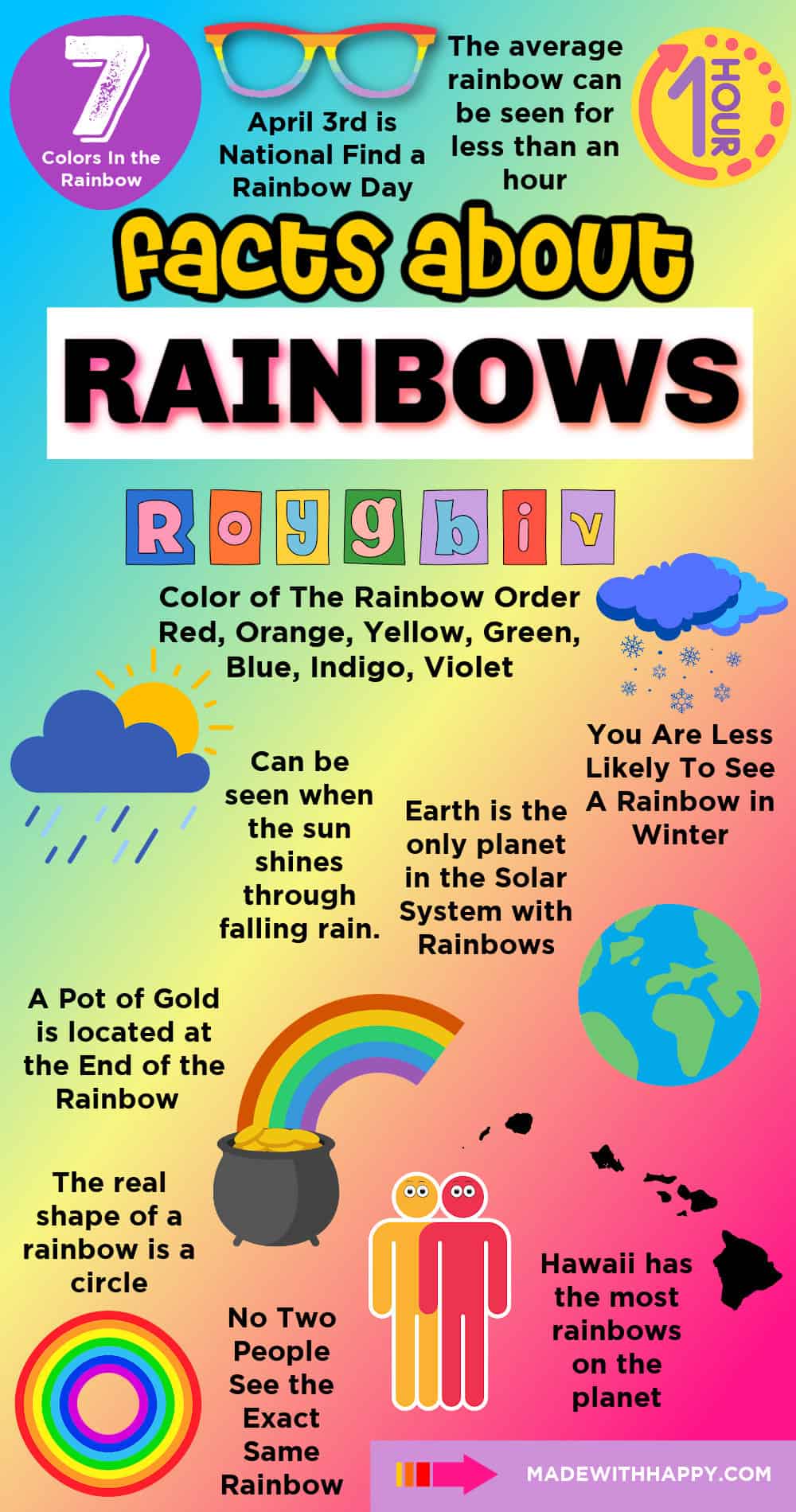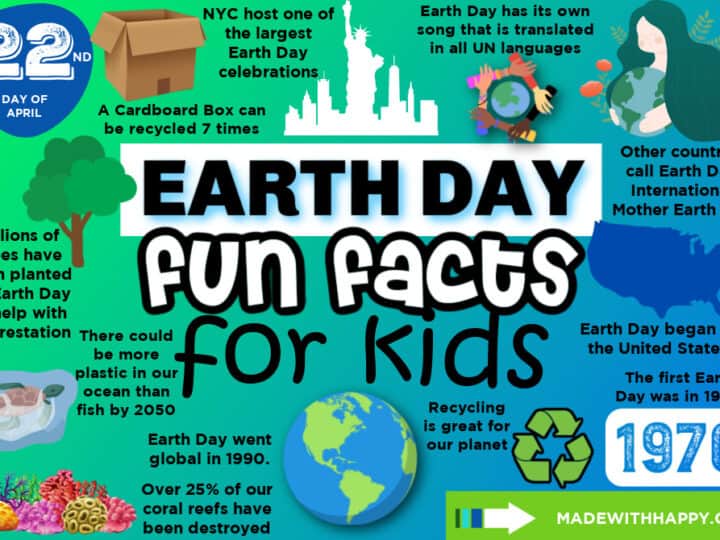Learn all the Fun Facts About Rainbows and trivia from how they form, the shape, the colors, and the symbols throughout history.

These Rainbow fun facts for kids of all ages are a great way to understand what rainbows are and how it was discovered. We're even sharing some fun trivia about the colors of the rainbow and where is the best place to see them!
Rainbows when seen in nature are awe-inspiring and one of the most beautiful wonders of the world.
There is even a printable infographic at the bottom of the post for long-lasting fun.
Check out our 365+ Fun Facts For Kids

Want to save this project?
Enter your email below, and then we'll send it straight to your inbox. Plus get awesome new projects from us each week.
What is a Rainbow?
A rainbow is a multicolored curved line in the sky when light is reflected through water droplets.
Rainbows can be caused by different types of light sources like the sun and the moon and any man-made light sources. The most common is sunlight.

How are Rainbows Formed?
When light travels through the air it travels in waves. Think of it as a wavey line. These are called wavelengths. Some light waves are shorter and some are longer. The light from the different wavelengths appears in different colors. Red is the longest of the light waves and violet is the shortest of the light waves.
When all the light waves blend together, they form a white light. Sunlight and light, in general, are white in color. When light rays hit a raindrop, the light bends (refracts) and the wavelength separates. You are actually seeing reflected light off the raindrop, and this is when you see each of the colors of the rainbow.
Also when light refracts, because the lights of different colors are different lengths, each color bends at different angles and the refracted light creates the arched shape of a rainbow. The red color is longer and therefore is on the outer edge and the violet color is on the inner edge.

Rainbow Colors in Order
There are many colors of a rainbow. Each color blends into the next without a hard line of distinction. However, there are seven distinct colors that are visible throughout the blending. They are red, orange, yellow, green, blue, indigo, and violet in that order.
The acronym ROY G. BIV is a great way to remember the rainbow colors in that order.
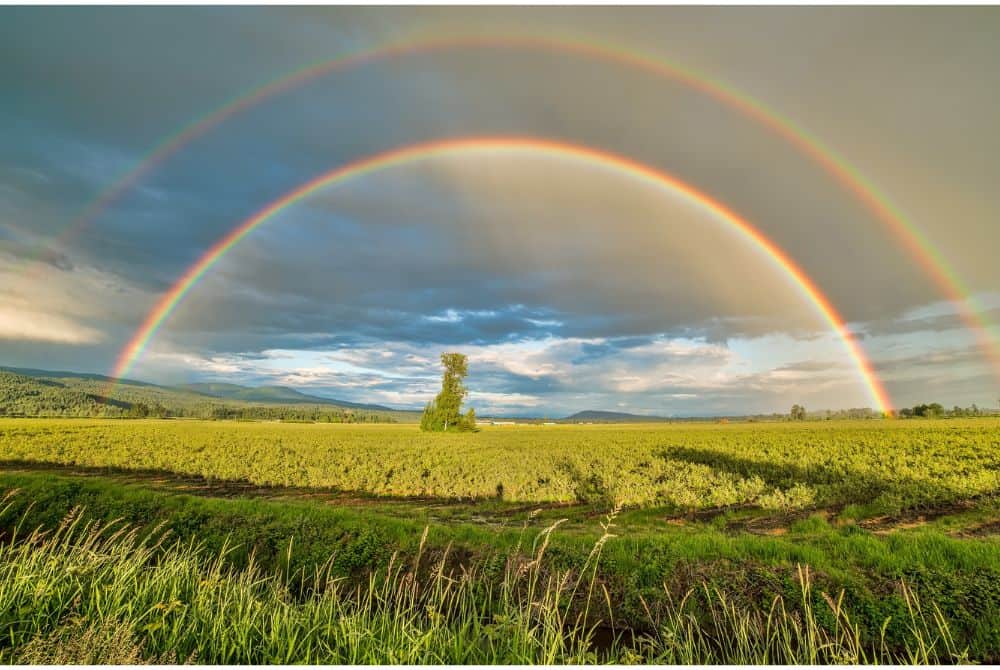
Types of Rainbows
There are actually many different types of rainbows. Here are some of the
Primary Rainbow
This is the most common type of rainbow that you see in the sky after rain.
Double Rainbow or Secondary Rainbow
When light is reflected twice in a raindrop.
Fogbow or Ghost Rainbow
Formed by cloud and fog droplets. They are also almost completely white in color. They are larger and wider than a rainbow.
Lunar Rainbow or Moonbows
Formed when moonlight (not sunlight) reflects through water droplets. All the colors are in the moonbows, but because the sun is 400,000 times brighter than the moon, our eyes see it as white.
Monochrome Rainbow or Red Rainbows
These are always a single-color rainbow. They usually occur at sunrise and sunset. It is at this time, light has to travel the furthest through the atmosphere. The shorter wavelengths scatter leaving the longest wavelengths (Red) visible. They are almost always red.
Supernumerary Rainbow or Stacker Rainbow
This happens when the light wave hits a water droplet and part of the colored waves reflects into a rainbow and the other part refracts in the opposite direction. They result in several faint rainbows, pastel in color.

- Full Circle Rainbow - Did you know that rainbows are also a full circle of light? However, most people see them from the ground, they only see them as an arc. From an airplane, you can see the complete circle rainbow.
- Supernumerary Rainbows - This extremely rare rainbow occurs inside a primary rainbow and acts like another band. This type is created when the sunlight hits drops of water 1 millimeter in size or less. These feature several pastel colors.
- Twinned Rainbow - Another rare rainbow. These form two rainbows with one base in common. One primary rainbow and one secondary. These occur when two rain storms happen and produce different size and shaped raindrops and two rainbows become one.
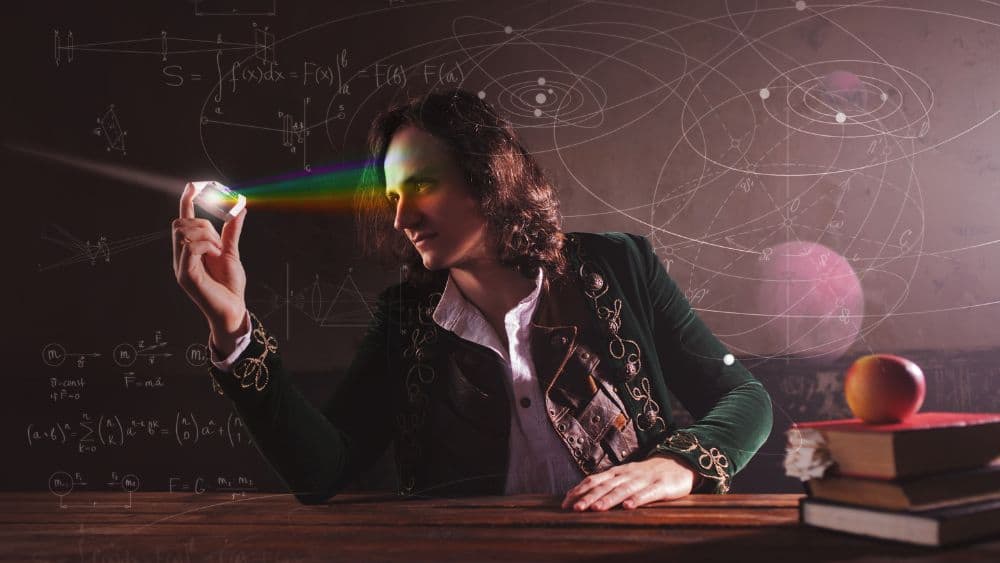
The History of Rainbows
- “Rainbow” comes from the Latin word arcus pluvius, meaning “rainy arch.”
- During ancient times, it was believed that the Goddess of the Rainbow, Iris, created rainbows as a path linking humans to the gods.
- Rainbows were often depicted throughout history, it wasn't till the 17th century that it was discovered what rainbows were.
- It was René Descartes, in 1637, who discovered that rainbows were light from the sun being split into different colors by the rain.
- Sir Isaac Newton, in 1666, identified the seven colors of the visible spectrum that make up white light.
- Irish Folklore believed that Leprechauns (short, red-haired men wearing green suits, as well as were the cobblers of the fairy world) would store their money from shoemaking in a pot of gold at the end of a rainbow.

Facts About Rainbows
- Rainbows are not located at a certain distance from the person viewing them. They are always visible from the person viewing location and at a 42-degree angle in the opposite direction of the sun reflected off the water droplets.
- Rainbows don't actually exist, they are an optical phenomenon (optical illusion) as well as you cannot touch a rainbow or reach the end of the rainbow.
- Also, this means that no two people see the exact same rainbow. Your location is slightly different from the person standing next to you, and therefore you and your friend are seeing two different rainbows.

- The average rainbow can be seen for less than an hour.
- The longest-seen rainbow lasted for just about 9 hours and was in Taipei, Taiwan in 2017.
- You are less likely to see rainbows in winter. This is because rainbows need water to reflect the light and in winter there is more snow than rainfall and therefore less beautiful colored arcs.
- Hawaii has the most rainbows on the planet.
- Planet Earth is the only planet in the solar system with rainbows. Astronomers do this because it is possible for rainbows to occur on Titan, Saturn's moon.
- You can never
- National Find a Rainbow Day is on April 3rd every year.
Red Facts

- Red is the color of fire trucks, stop signs, and emergency exit signs because it grabs people's attention and signals danger or caution.
- The color red can make your heart beat faster and even increase your appetite, which is why many fast-food restaurants use it in their logos and décor.
- In many cultures, red is the color of love and passion. That's why red roses are a popular choice for Valentine's Day gifts!
- Ladybugs are often red, and they're considered lucky in many countries. In some cultures, spotting a ladybug is believed to bring good luck.
- The planet Mars is often called the "Red Planet" because of its reddish color. It's named after the Roman god of war because of its fiery appearance in the night sky!
Yellow Facts
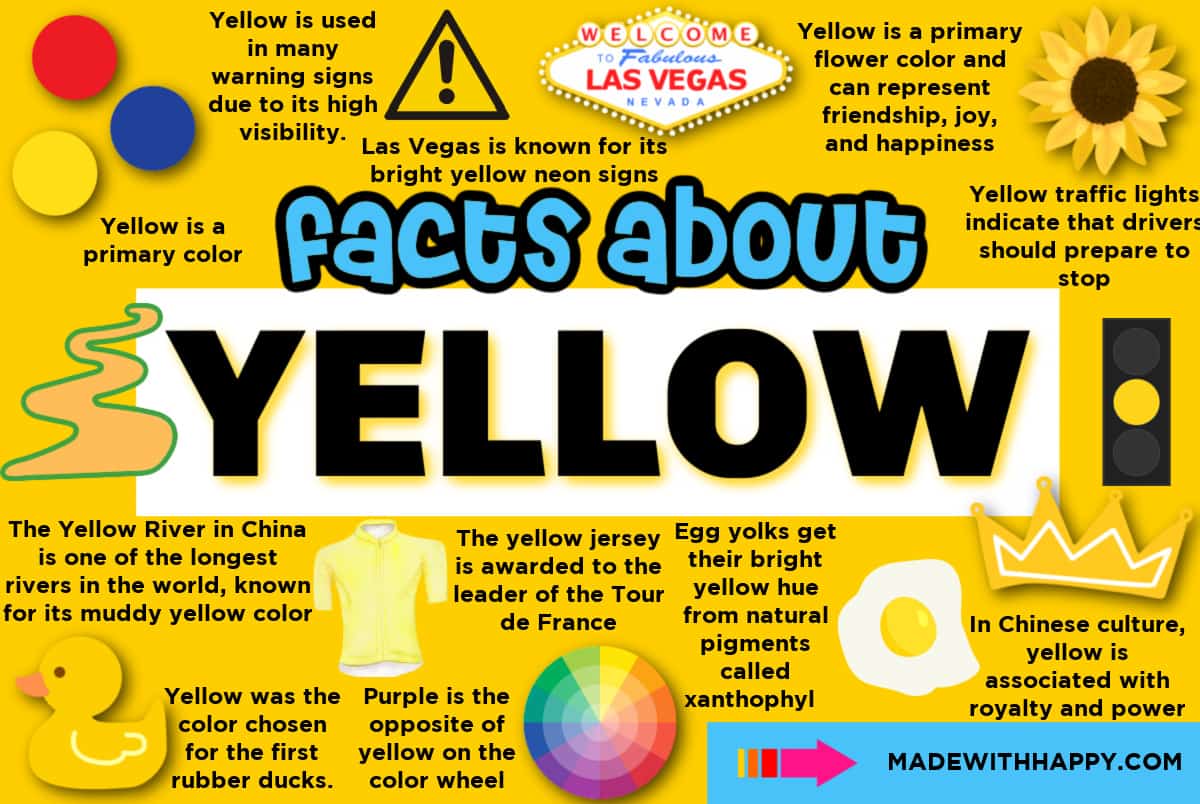
- Yellow is the color of sunshine and happiness! It's often associated with joy, warmth, and optimism.
- Bananas, lemons, and sunflowers are all yellow because they contain a pigment called carotenoids, which give them their vibrant hue.
- In many cultures, yellow is the color of caution and warning. That's why you'll see yellow caution signs and traffic lights.
- Yellow is the most visible color from a distance, so school buses, taxis, and road signs are often yellow. It helps them stand out as well as catch people's attention.
- Yellow is believed to stimulate mental activity and creativity. That's why some classrooms and workspaces are painted yellow to encourage productivity and focus!
Green Facts

- Green is the color of chlorophyll, the pigment that helps plants convert sunlight into energy through photosynthesis.
- The famous Statue of Liberty in New York City is green because it's made of copper, which has oxidized over time to form a green patina.
- In many cultures, green is associated with luck and prosperity. That's why people wear green on St. Patrick's Day and paint their doors green in some countries.
- Green is the color of envy and jealousy in some cultures, but it's also the color of renewal and growth, symbolizing nature's rejuvenation in spring.
- Green is the rarest natural eye color, with only about 2% of the world's population having green eyes. It's often considered mysterious and alluring!
Blue Facts
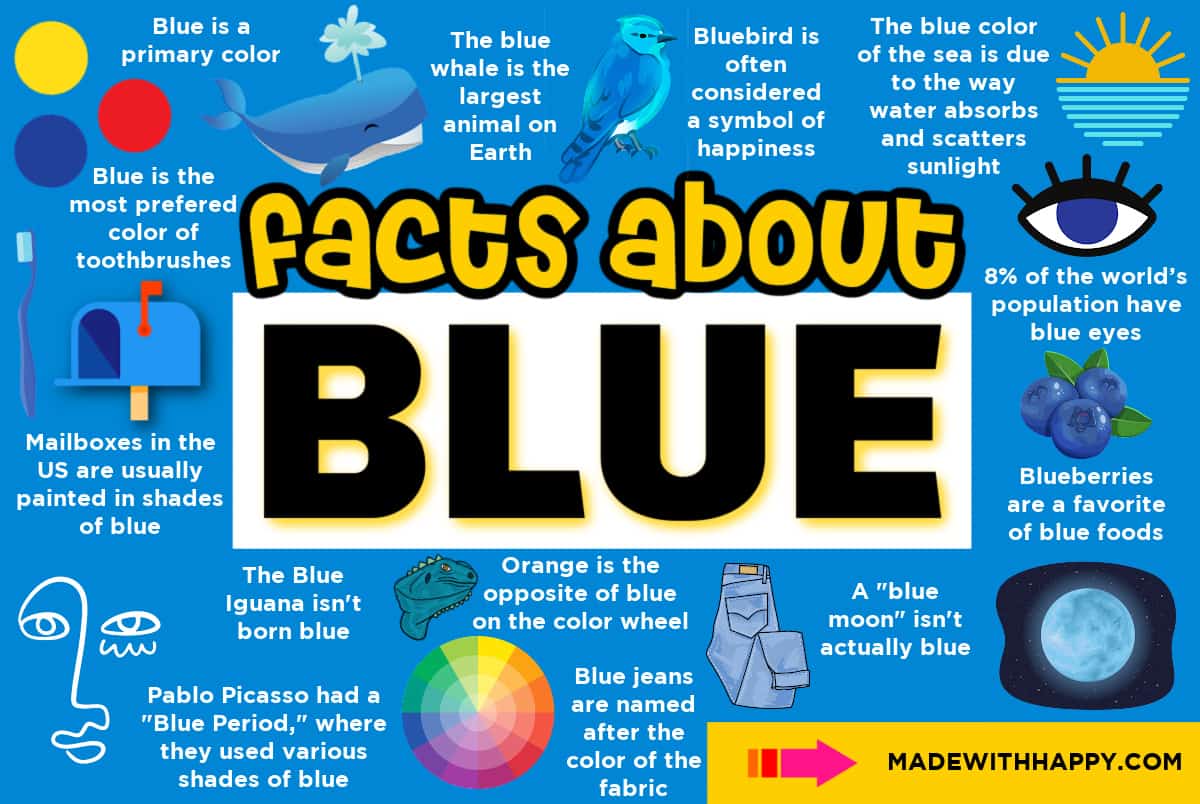
- Blue is the world's favorite color! Studies have shown that it's the most commonly chosen color across cultures and age groups.
- The ocean appears blue because water absorbs colors in the red part of the light spectrum, leaving blue as the dominant color that reflects back to our eyes.
- Blue is associated with calmness and tranquility. That's why it's often used in bedrooms as well as spas to promote relaxation and sleep.
- In many cultures, blue is the color of trust and stability. It's often used in corporate logos and uniforms to convey professionalism and reliability.
- Blue foods are rare in nature, but some exceptions include blueberries, blue corn, and certain varieties of potatoes. These foods contain natural pigments called anthocyanins, which give them their blue color.
Rainbows For Kids
Rainbows can be so much fun for kids of all ages. We have many different Rainbow Crafts, Treats, and activities that will be fun for the whole family but especially for kids. Check out these Rainbows for Kids to make their own rainbow.
Rainbow Crafts

We have a number of different crafts that celebrate rainbows and their beauty. For example, here are the top three.
Rainbow Snacks

Have some rainbow snack fun with these awesome rainbow treats that are sure to bring the colors of the rainbow to your food.
Rainbow Printables

We highlighted these Fun Facts along with some other fun kid's crafts in our March Crafts along with our 101+ Easy Craft Ideas for kids.
You also do not want to miss our 101+ Printable Coloring Pages For Kids and 101+ Printables For Kids full of Crafts and Coloring Pages.

Download The Free Rainbow Facts Infographic
Enter your email address in the form below and you'll be taken directly to the Fun Facts About Rainbows Infographic pdf file.
*For personal use only
CONNECT WITH MADE WITH HAPPY!
Be sure to follow me on social media, so you never miss a post!
Facebook | Twitter | Youtube | Pinterest | Instagram
Find and shop my favorite products in my Amazon storefront here!
FACTS ABOUT RAINBOWS
PIN IT TO YOUR DIY BOARD ON PINTEREST!
FOLLOW MADE WITH HAPPY ON PINTEREST FOR ALL THINGS HAPPY!
